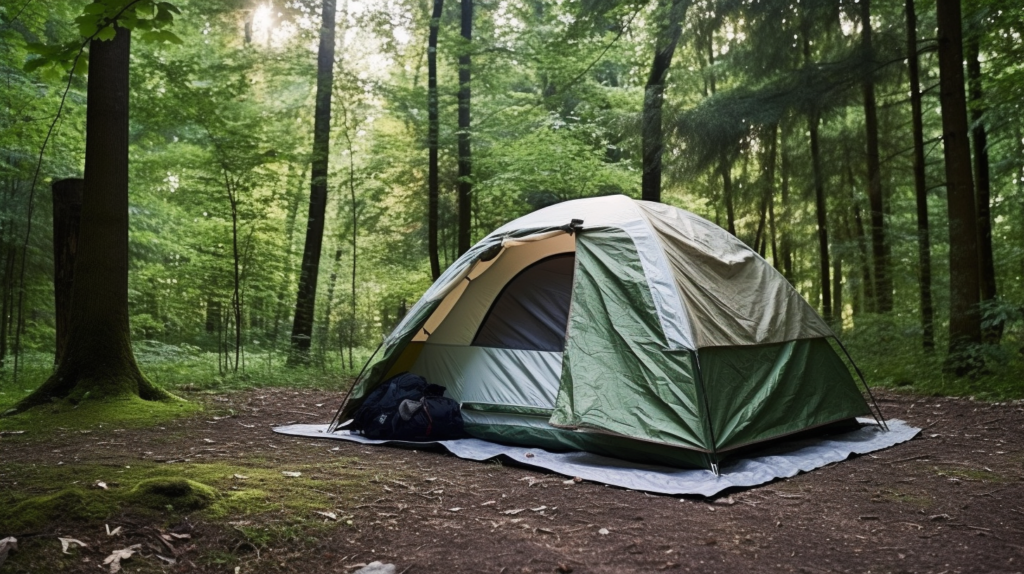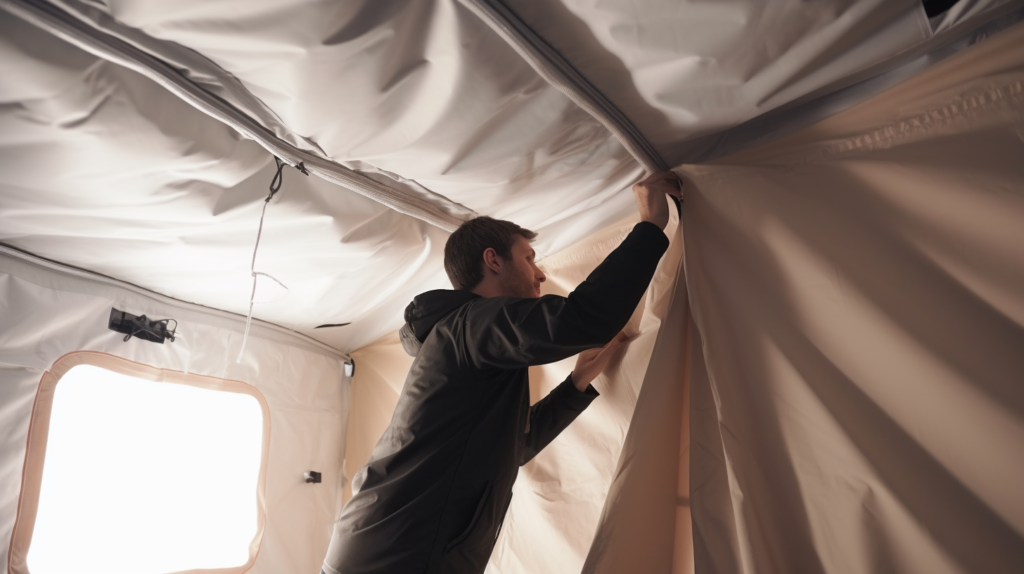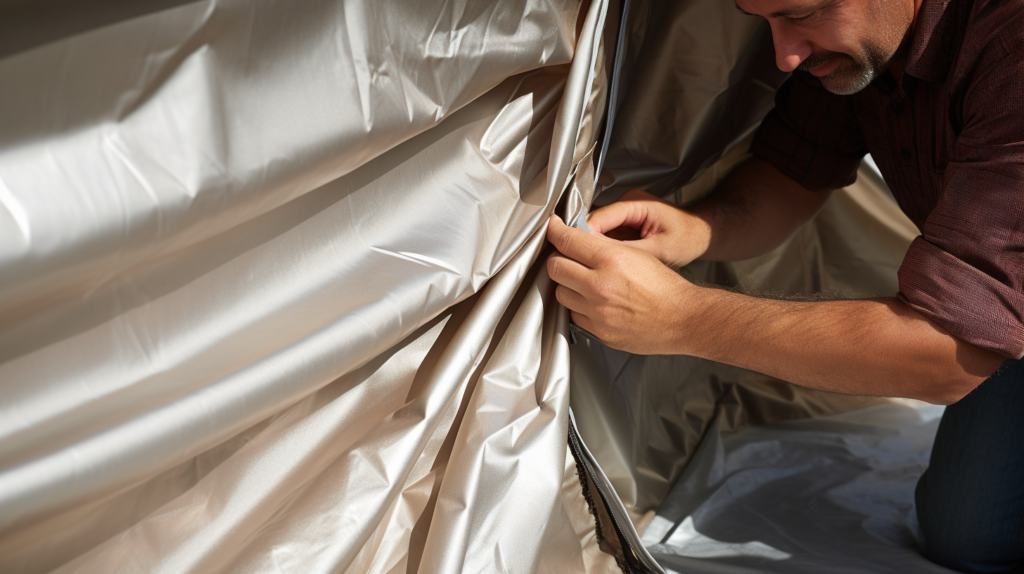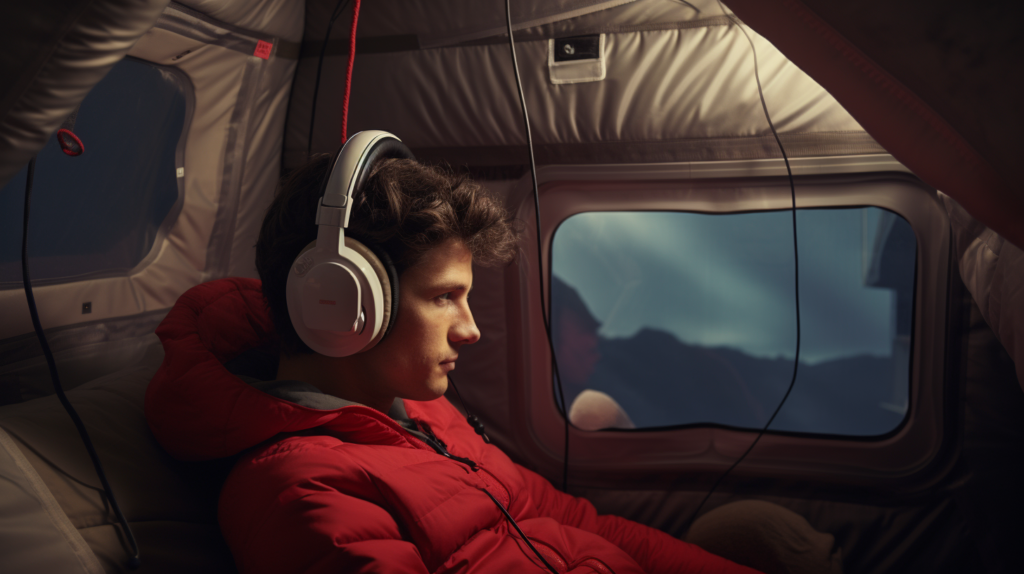Struggling to sleep through noisy campground disruptions? Learn how to transform any tent into a soundproof sanctuary.
Installing acoustic blankets, meticulously sealing openings, and using noise-blocking earbuds allows you to effectively soundproof your tent.
Let’s dive into the step-by-step process for creating a peaceful, quiet oasis inside your tent, no matter how loud the campground.
Why Should You Soundproof Your Tent?

Getting out into nature and going camping allows us to take a much needed break from the stress and distractions of everyday life.
Disconnecting from work, technology and routine enables us to relax, destress and simply be present. Many of us seek a peaceful, quiet environment when camping to aid relaxation and sleep.
Unfortunately, ambient noise pollution from nearby campers, roads, railroads, wildlife, parks and weather often invades the serene escape we expect when camping.
These sporadic unexpected sounds can be frustrating and disruptive when you’re trying to nap, converse, or fall into deep sleep at night.
The noise disruptions can leave you feeling more exhausted than refreshed. If sleep is constantly interrupted, you wake up groggy rather than recharged to take on the day.
The key to a restful camping experience is creating an oasis of quiet within your tent through sound dampening modifications.
By soundproofing your tent, you can block unwanted noises from penetrating inside, no matter how loud the environment outside.
Acoustic isolation enables you to fall asleep faster and achieve deeper, uninterrupted sleep throughout the night.
Studies show that continuous, high quality sleep recharges the mind and body, leaving you feel focused and energetic upon waking.
Soundproofing also provides the acoustic privacy to talk, laugh, unwind, play guitar and move about inside your tent without worrying about disturbing other campers.
You and your family can relax and comfortably be yourselves without bothering others. Without sound reverberations, activities seem less noisy to fellow campers.
With reduced external noise intrusion and internal sound buildup, you’ll find your tent becomes a calming retreat from the outside world – your own little sanctuary ideal for full rest and relaxation.
You can still enjoy serene nature sounds like birds chirping and trees rustling. Blocking disruptive chatter and distractions leads to a peaceful night’s sleep. Follow the steps below to soundproof your tent.
Steps to Soundproof Your Tent

Achieving significant noise reduction inside your camping tent is very doable using the following straightforward soundproofing techniques:
1. Install Acoustic Blankets on Walls and Ceiling

The most effective way to prevent unwanted external noises from intruding into your tent is to install heavy sound absorbing blankets and quilts on the interior walls and ceiling.
Covering all tent surfaces creates an acoustic barrier that blocks sound.
Look for thick, heavyweight blankets and quilts with multiple layers of dense fabric and insulation. Moving blankets, voice recording blankets, or thick comforters work well.
Avoid thin, porous fabrics. Drape them around walls and the ceiling using binder clips, clasps, tape or weights to create a tight seal without gaps.
Overlap the blanket seams by 6-12 inches so no part of the tent exterior is exposed.
The more coverage, layering and surface area you can cover with heavy acoustic blankets, the more outside noise will be prevented from entering your interior space.
Completely covering all four tent walls and the ceiling provides a full acoustic cocoon.
Install the blankets snugly from corner to corner. Any sagging areas, protruding corners or openings leave vulnerabilities where sound can penetrate.
Treat each wall individually making sure edges are flush and secure. Maintain blankets annually by resealing any holes or worn sections. Thorough acoustic blanket installation truly optimizes tent soundproofing.
2. Seal All Gaps and Openings

In addition to blanket installation, you must meticulously seal any gaps, holes or openings in the tent fabric beneath.
Even tiny gaps or lifting at blanket edges/seams can compromise the acoustic isolation and allow noise to leak through. Sound will find any permeability weaknesses.
Use acoustic sealant tape to cover all seams between tent panels beneath the blankets. Look for aluminum-coated cloth tape designed for sealing air gaps in buildings and HVAC systems.
Press the tape firmly in place for full adhesion. Acrylic sealant works better than rubber which deteriorates over time.
Cover all zippers, ports, vents, openings and overlaps using tape, hook/loop patches or flap covers. This includes door zippers, ceiling vents, electrical ports and stove jackets.
Avoid permanent adhesives that leave sticky residue if removed later. Thoroughly tape down any mesh screens or vent holes.
For maximum coverage, run acoustic tape around the tent’s perimeter where blankets meet the floor. Weigh down any dangling blanket edges using pockets filled with rocks or sand bags.
Prevent air exchange or sound leakage underneath the barriers.
Inspect annually looking for new gaps and re-tape if any adhesive seems loose. Apply additional tape wherever noise leaks through.
Maintain a completely airtight acoustic seal on your tent for optimal noise blocking performance. An impermeable soundproof tent cocoon requires meticulous sealing.
3. Use Noise Canceling Headphones and Earplugs

In addition to physically soundproofing your tent exterior, also utilize headphones and earplugs to internally soundproof your ears from any remaining ambient noise that gets through.
This balances external tent modifications with internal sound masking for maximum acoustic isolation.
Noise canceling headphones electronically cancel outside sounds using tiny built-in mics to pick up noise and circuitry to generate an inverse audio signal cancelling it.
Look for adequate noise reduction ratings when purchasing over-ear muff models. Use them to listen to music, podcasts or nothing at all without noisy distractions.
For sleeping in noisy environments, wear disposable foam earplugs with a high NRR of at least 32 decibels. The compressible foam expands snugly in your ear canal to fully block sound.
However, they can feel uncomfortable with prolonged use. Reusable molded silicone or wax earplugs are a comfortable, eco-friendly option for multi-day trips.
Carry a protective case for reusable earplugs to prevent losing or dirtying them when not worn. Replace disposable foam earplugs frequently as the material degrades with use and compression.
Combine these easy personal soundproofing options with tent modifications for peaceful quiet anytime.
Conclusion
Completely covering your tent in acoustic blankets, vigilantly sealing any gaps or perforations, and wearing sound blocking ear protection makes creating an oasis of quiet within your tent straightforward.
Follow these steps and even noisy campground conditions will not disrupt your ability to unwind, chat, play and sleep undisturbed.
Blocking unwanted chatter, music, vehicles and other distractions leads to deeper, uninterrupted sleep all night long.
You can finally wake up feeling refreshed and energized rather than groggy after a fitful night.
Soundproofing allows you to fully relax, decompress and recharge no matter how noisy the world outside your tent.
Reconnect with nature and loved ones in your own personal soundproof sanctuary.
